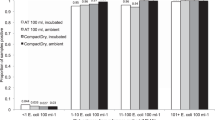Abstract
Faecal contamination is a major causative factor for incidence of water borne infectious diseases. Certain hydrogen sulfide (H2S) producing enteric bacteria such as Salmonella sp. and Citrobacter sp., assosiated with coliforms, have been considered for rapid detection of recent faecal contamination in water. The basic H2S test medium, modified by adding 0.25 gm/L of L-cystine HCl, was examined for its efficiency with 90 water samples collected from 40 pipe supplies, 20 open wells, 15 hand pumps and 15 different surface water bodies (river, streams and ponds). Sterilized modified culture medium in glass vials was inoculated with 100 mL of each sample and incubated at 20, 25, 30, 35 and 44 ∘C for 18, 24, 42, 48, 66 and 72 h. Blackening of content in incubated vials was considered positive. For comparison, most probable number (MPN) of coliform and faecal coliform per 100 mL was also estimated in each sample by multiple tube fermentation (MTF) method. H2S positive result was exhibited by 78% of samples. Coliform (> 10) and faecal coliform/100 mL were also detected in 59% of samples. Maximum H2S positive results (100%) were found with well and surface water samples incubated at 30, 35 and 44 ∘C for 18 h. Coliform (> 10) and faecal coliform/100 mL were also detected in most of these samples. Pipe supplies (60%) and hand pumps (73%) also exhibited considerable H2S production. Coliforms and faecal coliforms were also found in significant number of these samples. Thus, the modified H2S test may prove a useful alternative indicator of faecal contamination for water quality surveillance and screening of large number of water samples in short duration, particularly during any outbreak of water borne disease among rural population.
Similar content being viewed by others
References
Allen, M. J. and Geldreich, E. E.: 1975, ‘Bacteriological criteria for ground water quality’, Ground Water 13, 5–52.
APHA: 1998, Standard Methods for the Examination of Water and Waste Water, 20th ed. American Publication Health Association, Washington D.C.
Castillo, G. Duarte, R., Ruiz, Z., Marucic, M. T., Honorato, B., Mercado, R., Coloma, V., Lorca, V., Martins, M. T. and Dutka, B. J.: 1994, ‘Evaluation of disinfected and untreated drinking water supplies in Chile by the H2S paper strip test’, Water Res. 28, 1765–1770.
Gawthorne, T., Gibbs, R. A., Mathew, K. and Ho, G. E.: 1996, ‘H2S papers as presumptive tests for Salmonella contamination in tropical drinking water’, Water Sci. Technol. I, 187–194.
Grant, M. A. and Zeil, C. A.: 1996, ‘Evaluation of a simple screening test for faecal pollution in water’, J. Water SRT, Aqua 45, 13–18.
Hu, C. J., Gibbs, R. A. and Ho, G. E.: 1995, ‘Detection of Salmonella in Composted Waste Water Sludge’, Environ. Sci. Report No. 95/5. Murdoch University, Western Australia, p. 38.
Kromoredjo, P. and Fujioka, R. S.: 1991, ‘Evaluating three simple methods to assess the microbial quality of drinking water in Indonesia’, Environ. Toxicol. Water Qual. 6, 259–270.
Kodaka, H., Mizuochi, S., Honda, T., Yamaguchi, K.: 2000, ‘Improvement of mannitol lysine crystal violet brillant green agar for the selective isolation of H2S positive Salmonella’, J. Food Protec. 63, 1643–1647.
Mallinson, E. T., Miller, R. G., de Rezende, C. E. Ferris, K. E. Degraft, H. J. and Joseph, S. W.: 2000, ‘Improved plating media for the detection of Salmonella sp. with typical and atypical hydrogen sulphide production’, J. Vet. Diagn. Invest. 12, 83–87.
Manja, K. S., Maurya, M. S. and Rao, K. M.: 1982, ‘A simple field test for the detection of faecal pollution in drinking water’, Bull. WHO 60, 797–801.
Manja, K. S. and Kaul, R. K.: 1992, ‘Efficacy of a simple test for bacteriological quality of water’, J. Ind. Assoc. Environ. Manage. 19, 18–20.
Pillai, J. Gibbs, R., Mathew, K. and Ho, G. E.: 1997, ‘Bacteriological Water Testing by H2S Method’, in: Proceeding of 23rd WEDC Conference on ‘Water and Sanitation for All: Partnerships and Innovation’, Durban, South Africa, pp. 289–292.
Santiago-Mereado, J. and Hazen, T. C.: 1987, ‘Comparison of four membrane filter methods for fecal coliforms enumeration in tropical waters’, Appl. Environ. Microbiol. 53, 2922–2928.
Singh, A. and McFeters, G. A.: 1992, ‘Detection Methods for Water Borne Pathogens’, in: R. Mitchell (ed.) Environmental Microbiology, 1st ed. New York, Liss.
Venkobachar, C., Kumar, D. Talreja, K., Kumar, A. and Iyengar, L.: 1994, ‘Assessment of bacteriological water quality using modified H2S strip test’, J. Water SRT Aqua 43, 311–314.
Author information
Authors and Affiliations
Corresponding author
Rights and permissions
About this article
Cite this article
Pathak, S.P., Gopal, K. Efficiency of Modified H2S Test for Detection of Faecal Contamination in Water. Environ Monit Assess 108, 59–65 (2005). https://doi.org/10.1007/s10661-005-3960-y
Received:
Accepted:
Issue Date:
DOI: https://doi.org/10.1007/s10661-005-3960-y




